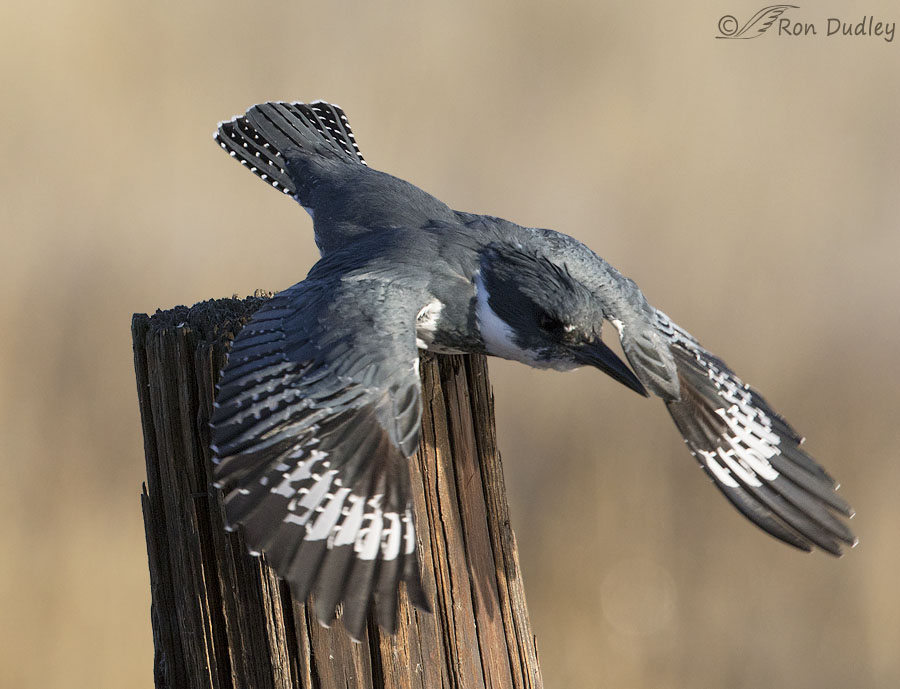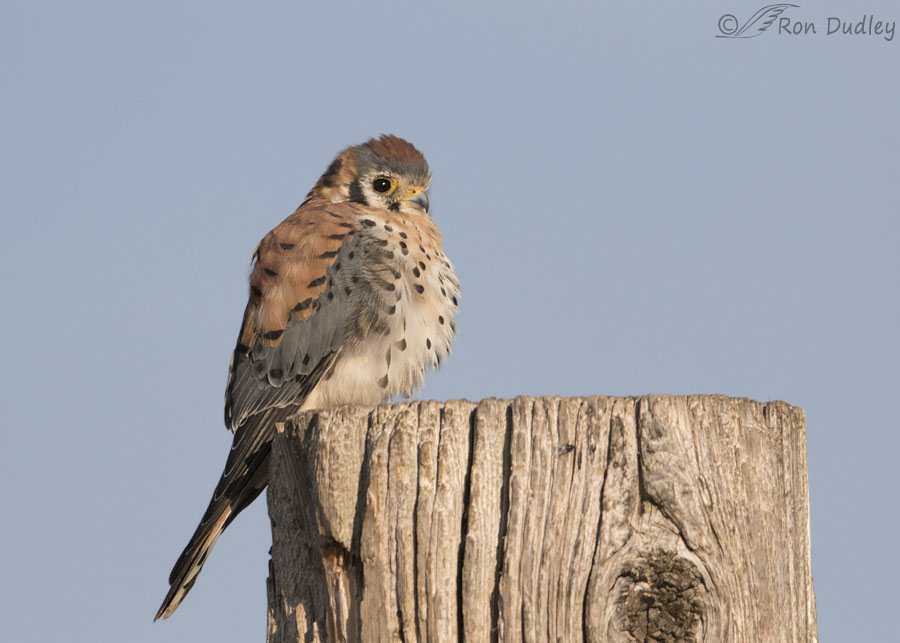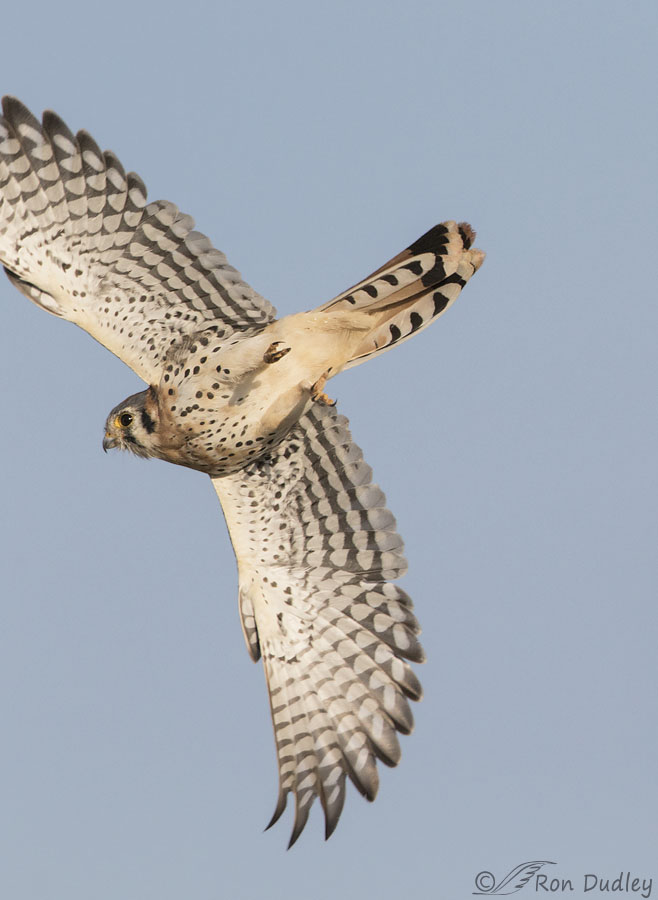I often pay nearly as much attention to my failed takeoff and flight shots as I do to my successes.
I do it because analyzing and understanding mistakes I made and/or what I could have done better given my equipment and skill set might turn the next similar situation into a raging success. But it’s also important to realize that getting a mediocre shot or no shot at all doesn’t necessarily mean photographer error or lack of skills. Birds are tough and notoriously uncooperative subjects, particularly during takeoff or in flight, and much of the time even the most skilled photographer couldn’t make a silk purse out of that pig’s ear.
A couple of cases in point.

1/2500, f/7.1, ISO 640, Canon 7D Mark II, Canon EF 500mm f/4L IS II USM + EF 1.4 III Extender, not baited, set up or called in
I could have loved this shot of a Belted Kingfisher taking off but it has at least two major flaws – the side of the face we see is deeply shaded with very little detail (including no catch light in the eye) and the perch is sharper than the bird.
But in this situation there’s very little I could have done about the light angle on the kingfisher because I can’t control where the sun rises in the east and I can’t control which direction the bird might take off. I stopped my pickup on what I judged to be the best spot to get at least decent light on the bird in this sidelight situation and still be relatively close to it. The rest is up to chance, the whims of the bird and the gods of photography.
But perhaps the kingfisher would have been sharper if I’d been using more active focus points than the five at center I believe I had activated. This shot is cropped to about the lower right third of the frame so it looks like those few points I had activated stayed locked onto the post instead of following the kingfisher.
Next time I’ll consider using additional active focus points in situations like this.

1/2500, f/7.1, ISO 640, Canon 7D Mark II, Canon EF 500mm f/4L IS II USM + EF 1.4 III Extender, not baited, set up or called in
Two days ago at Farmington I found this male American Kestrel on a favorite raptor perch at the refuge. I’m not fond of photographing kestrels on this post because these small falcons are dwarfed and overwhelmed by the massive perch. But I had a decent chance for a takeoff or flight shot so I removed my teleconverter and began to wait him out.
I didn’t have to wait long because through my rear view mirror I saw a duck hunter’s stinky and loud diesel pickup I was familiar with approaching on the gravel road behind me. I anticipated the noisy pickup might flush the kestrel so I tried to prepare for it as best I could. Kestrels, especially when they’re flushed by something, take off at lightning speed and in unpredictable directions so the trick would be keeping him in frame when and if he did so.
My plan was to try to begin firing a burst just before he took off so I had to guess from the noise from the truck how close it was (I was looking through my viewfinder and couldn’t see the pickup coming) and hope for two things – that the kestrel took off at an angle that would give me a nice photo or two (no butt shots please) and that I timed the beginning of my burst just right.

1/2500, f/7.1, ISO 640, Canon 7D Mark II, Canon EF 500mm f/4L IS II USM, not baited, set up or called in
I came close but no cigar. I cut off part of his left wing and the bird was beginning to turn away from me because I waited a few nanoseconds too long to begin my burst. I was bummed by this one because I can imagine in my mind the potentially spectacular flight pose I might have had given this quirky takeoff angle if I’d started the burst just a little sooner.
But in this situation, a common one at the refuge and elsewhere with traffic approaching me from either direction, I don’t think I’ll make the same mistake again. Unlike film, pixels are cheap so it doesn’t matter much if I “waste” ten or twenty shots because I started my burst a second or two early. They would be pixels well spent.
So yes, I do bitch and moan when I miss potentially great shots like these but if I use them wisely as a resource for learning it shouldn’t happen as often in the future.
Ron


I love your tutorials also. I learn and I feel better about my own mistakes.
Between not having a working computer and the scarcity of birds I have not been out photographing. When I do I can’t believe how rusty I have become. I make stupid mistakes like too much motion in my rush to get the shot. Not getting the active sensor on the focal point and one day I forgot to bing an empty memory card. To top it off by the time the weekend arrives we have weather like today!
It’s a conspiracy, April. I swear it is, especially regarding the weather!
Every bird photographer makes mistakes. All we can do is try to reduce their frequency.
Thank you.
And hooray for cheap pixels. I remember (only too well) waiting for film to be processed and paying for less than stellar shots. The lessons I learned were both expensive and slow.
I learned those same lessons, EC. It makes me admire spectacular birds shots taken on film even more. Those photographers must have had either incredible skills or a bottomless bank account. Or both.
Both I suspect. And a smidgeon of luck.
Thanks for the lesson, Ron. Although I love your successes, I learn a lot more from your errors. As Everett Sunburn more or less says, kingfishers are soooo difficult.
“Although I love your successes, I learn a lot more from your errors”
Then you should learn a lot here on Feathered Photography, Nancy!
My first reaction to that Kingfisher shot was that it would make an interesting carving…still think so…reminds me of a diver…too bad about the raptor…
You’re right, Patty. The kingfisher shot has good potential as a carving, partly because the bird is probably still touching the perch.
These images point out that It’s easy to assume you come by your photos naturally and with little effort after years of practice, when in fact you must employ all your hard-earned skills to produce what we merely click on our computers to enjoy.
Very insightful of you, Lyle. These types of shots are never, ever easy!
It’s the measure of your skills to be able to determine your number of focus points was probably the issue with the Kingfisher – at first glance I’d have thought my shutter speed was too slow tho when REALLY looking I can see it was something else! That would have been a helluva shot! Thx for the tutorial! Yes, pixels are cheap – I just hate going through a kazillion photo’s
Thx for the tutorial! Yes, pixels are cheap – I just hate going through a kazillion photo’s  My attention span is VERY short!
My attention span is VERY short!  -4 here this morning BUT sun is going to shine!
-4 here this morning BUT sun is going to shine! 
“That would have been a helluva shot!”
I think so too, Judy – if the bird had been sharper and there was light on the face and eye. “Little things” become huge in situations like this.
We just had a storm front move in here from the north so you must have had it yesterday. Right now it isn’t particularly cold but there’s supposed to be snow in the mountains.
Very interesting and educational Ron. The kestrel photo would have been outstanding had you gotten it all. I laughed though thinking of the kingfisher. Of all the birds to try to photograph during a takeoff I don’t think it gets much harder than the extremely erratic and unpredictable kingfishers. Let’s see, in what direction will the kingfisher take off – left, right, up, down? Or maybe something totally unpredictable like a quick move to the left followed by lightening quick change of direction so fast that no photographer could ever follow. And of course along with the speedy departure comes that irritating rattling scream that almost sounds as if he or she is laughing at you as it flies away.
Everett Sanborn, Prescott AZ
Yup, you’ve got those quirky kingfisher moves down pat, Everett. And their seemingly mocking call after they’ve bamboozled the photographer once again.
Wonderful post – learn from your mistakes – good lesson! I have to admit I’ve learned a ton from your blog over the years, it is much appreciated!
“learn from your mistakes”
Ha, that means I have a hell of a lot of learning to do, Dick! Thanks.
You are very generous to share the errors in photography; many only share or speak about the triumphs. Even though the first photo is ‘flawed’ I really like the detail of the tail feathers. The last photo would have been spectacular…you even had the catch light! Sometimes as you say there is nothing you can do about the light angle. Without that spark of light in the eye there is a ‘bit of bird-zombie’ look to the photo. I think that is the most obvious flaw that I first check for with my photos when I download. Thanks for sharing; I always learn something.
“Without that spark of light in the eye there is a ‘bit of bird-zombie’ look to the photo.”
Exactly, Kathy. Hollywood film directors and editors even go so far as to remove catch lights in the eyes of villains to give them a “dead” look. Catch lights are THAT important to giving our subjects life.
Very good post Ron! Great info for photographers trying to get BIF shots.
That was my goal, Bob. I had mentors when I was learning the basics (Richard Ditch and Tom Webster come to mind but there were others) and I guess this is my way of paying it back. Thanks.